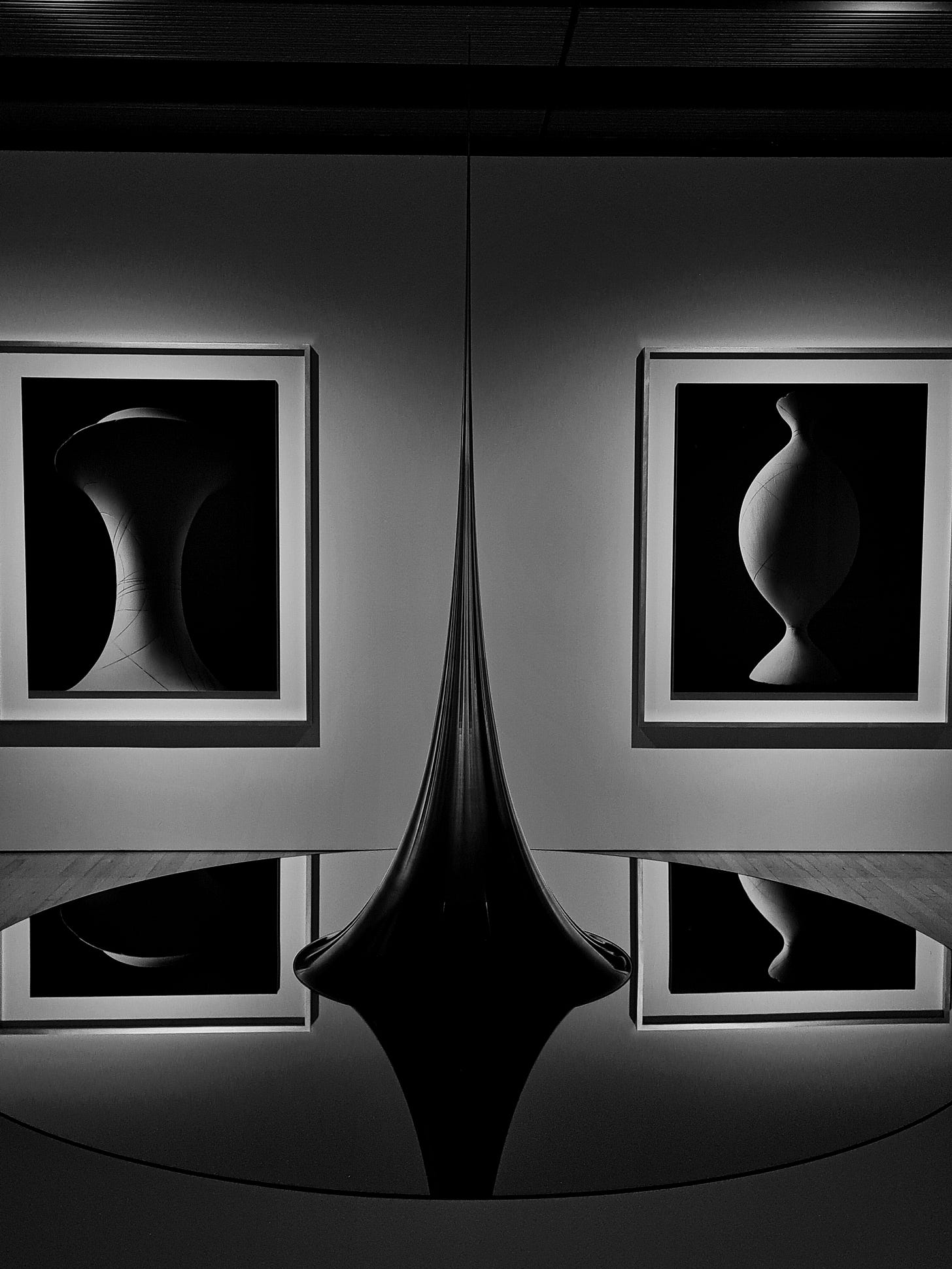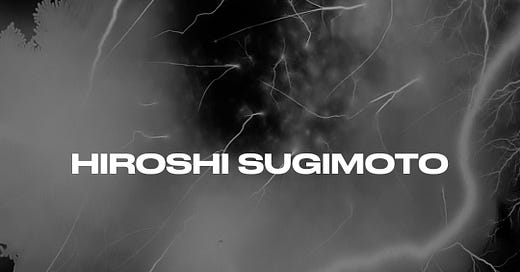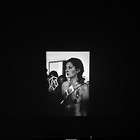Recommended song to dress your background with, while you read <<>> Listen to L’INSTANT+ playlist on Spotify*
Suggestion musicale comme toile de fond pour votre lecture <<>> Écoutez la playlist de L’INSTANT+ sur Spotify*
Precise and sleek. How I received his photography. Hiroshi Sugimoto’s highly scientific process of materialising creativity disturbed me.
His Lightning Fields series is probably my favourite, but how can one leave indifferent to his eerily empty Theaters. Sugimoto set the exposure time to match the film's length about to begin — speaking of patience’s mastery. The results are impressively mesmerising, both in concept and imagery. The cinema screen becomes the only light source in his photographs, dialoguing with the architecture surrounding it. Time extends yet freezes in one photograph; contradiction might be key in his work. Even more striking in his Dioramas, where animals come back to life. A sense of calm owned the exhibition space; serene, meditative, captivating — a temple of imagery.
Épurée et précise. C’est ainsi que je décrirais sa photographie. Son procédé créatif si scientifique m’a perturbée.
Sa série d’éclairs est probablement ma préférée, même si l’on ne peut pas rester indifférent à ses théâtres fantomatiques. Sugimoto utilise un temps d’exposition égal à la longueur du film sur le point de commencer — qu’on me parle de patience et de dévouement. Les résultats sont hypnotiques et impressionnants, à la fois dans le concept et l’image. Avec l’écran de cinéma comme seule source de lumière dans ses photographies, l’architecture de ces bâtiments semble entamer un dialogue avec elle. Le temps s’allonge et se fige en l’espace d’une image ; l’idée de contradiction résumerait peut-être son oeuvre. Ses Dioramas ont bien rescucité des animaux empaillés. Il existait une certaine sérénité dans l’espace d’exposition ; sereine, méditatif, captivant, un temple de l’image.
Photographer but also a practising architect and model maker — he does not consider himself a sculptor — Sugimoto began learning photography at 12 when his father bought an expensive camera, the Mayima 6 camera. Struggling to use it, he passed it down to his son and turned his closet into a darkroom. I invite you to explore his photographic debuts and Seascapes series in the video documentary shared at the end of your read.
Daydreaming at school, pondering whether the world exists merely as his hallucinogenic vision, it comes as no surprise that he first envisions his photography within his mind, which then becomes a vision that he materialises. I often find myself intrigued by the work of artists who have mastered the art of transforming a creative mistake into their signature style. Sugimoto’s inspiration for Lightning Fields originally stemmed from a technical issue. When removing a sheet of film from its holder, the friction sometimes generates static electricity, which can mar the film and obliterate the image.
Blurring the lines between reality and fabrication, somehow echoing our era of deepfakes and AI, diving into his work is willingly, or not, accepting to be deceived.
Photographe mais également architecte et modéliste (il ne se reconnaît pas dans le titre de sculpteur), Sugimoto découvre la photographie à l’âge de 12 ans, lorsque son père s’offre un appareil photo, le Mayima 6 plus précisément. Prenant conscience combien il est difficile de l’utiliser, il abandonne l’idée et l’offre à son fils, transformant son placard en chambre noire. Je vous invite à découvrir ses débuts photographiques et sa série Seascapes dans le documentaire vidéo partagé en fin de lecture.
Rêvassant à l'école et se demandant de quoi le monde se constituait, s’il n'était peut-être que l'objet de ses hallucinations, c'est sans surprise que sa photographie prenne vie dans son esprit, une vision qu’il matérialise ensuite. Je me retrouve souvent à apprécier les œuvres d'artistes ayant su tirer profit d'erreurs créatives pour en faire leur signature. L'inspiration derrière la série Lightning Fields de Sugimoto a découlé d’un problème technique. Lorsqu’une feuille de film est retirée de son support, il arrive qu'un frottement puisse provoquer une étincelle d’électricité statique, pouvant entailler le film, détruisant ainsi l’image.
Brouillant les frontières entre réalité et fabrication, reflétant peut-être notre époque de deepfakes et IA, plonger dans ses oeuvres, c’est volontairement, ou non, accepter de se tromper, de se perdre dans le labyrinthe de ses pensées.
“Not depicting the world in photographs, I’d like to think, but rather projecting my internal seascapes onto the canvas of the world.”
— Hiroshi Sugimoto

In his eyes, one shouldn’t become an artist in one’s twenties; a life must first be lived. In a time when existing or surviving seems more accurate than truly living for most, perhaps Sugimoto’s words should awaken the creative call in us that we have left in sleep mode — for far too long. We perhaps shouldn’t give in so easily to the fear that changes represent but rather feed our souls from it. Working harder and showing some serious will could help us achieve those dreams. Or simply, to live.
À ses yeux, on ne peut devenir artiste qu’après avoir vécu sa vie ; pas question de devenir artiste dans sa vingtaine. Alors que notre époque inspire plutôt la survie qu’une existence richement approfondie, peut-être que les mots de Sugimoto devraient éveiller en nous cet écho créatif longtemps mis sous sourdine. Peut-être que la peur que les changements amènent avec eux devrait servir de carburant dans la libération de nos âmes. Et peut-être que s’acharner plus souvent, d’en vouloir vraiment, nous permettrait de les réaliser, ces rêves bouillonnants. Ou d’apprendre à vivre, tout simplement.
+
FOR THE CURIOUS AND THE GREEDY
POUR LES CURIEUX.SES
. . .
Southbank Centre, Hiroshi Sugimoto [articles + videos]
Hiroshi Sugimoto, Official website
Louisiana Channel, Hiroshi Sugimoto Interview: Advice to the Young
Art21, Hiroshi Sugimoto’s biography
Interview Magazine, Hiroshi Sugimoto’s Future
ArtReview, Hiroshi Sugimoto’s Time Machine
Aperture, A Lesson in Art History from Hiroshi Sugimoto
UPCOMING EXHIBITIONS
PROCHAINES EXPOSITIONS
. . .
JAPAN
Pola Museum, Hakone: "The Secret of Color - from Impressionism to Contemporary Art"
Dates: December 14, 2024 – May 18, 2025
Benesse Art Site, Naoshima: "Hiroshi Sugimoto Gallery: Time Corridors"
Dates: March 12, 2023 – Ongoing
USA
Lisson Gallery, Los Angeles: "Form is Emptiness, Emptiness is Form"
Dates: November 15, 2024 – February 1, 2025
Edited images by yours truly of the Hiroshi Sugimoto: Time Machine exhibition showcased at The Hayward Gallery, London, 11 Oct - 07 Jan 2024.
Images retouchées, sincèrement vôtre, de l’exposition Hiroshi Sugimoto: Time Machine présentée à la Hayward Gallery, Londres, 11 Oct - 07 Jan 2024.
R E A D / L I S T E N — N E X T










I was very interested in Sugimoto twenty years ago. His minimalist but perfectionist approach fed me up at the end, everything arranged without even a gap to ‘let living’. The wax museum series really boring. The sea for instance treated as an intellectual concept (because his shots are sooo long) instead of like a materials source of living. Oh, but he sells very well at high prices and galleries are proud to get their commissions. Commercial stuff
Nice! Sugimoto is a very interesting man. He has dabbled in a lot of things. He recently did the interior design of a condo in New York, which was for sale for a cool $135 million. I apologize in advance for the agent, he would definitely not be my choice, but the Sugimoto touch is very interesting (youtube video is linked below). He was responsible for a glass tea-house in Venice - a temporary installation - a few years ago, which turned traditional Japanese architecture on its head. His theatres are still my favourite.
Here is the condo: https://www.youtube.com/watch?v=8Iw5lxkQibU
Thank you for bringing Sugimoto to the front row! He deserves it!